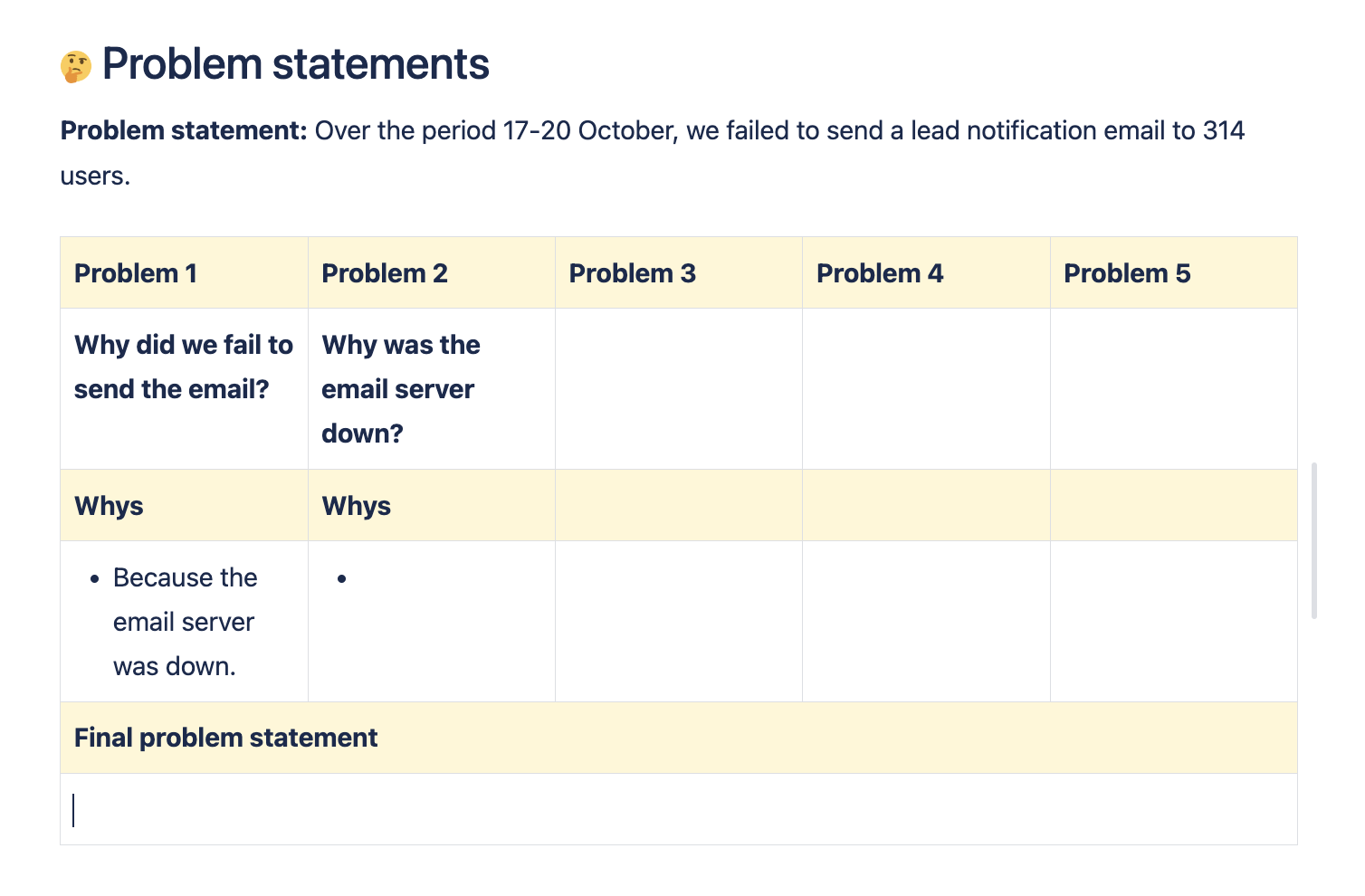5 Whys Analysis
If a project does not meet expectations despite your team’s efforts, take a moment to identify the root cause. The 5 Whys Analysis Play helps your team ask "why" multiple times until they uncover the core issue.

PREP TIME
5m
Run TIME
30m
Persons
3-8
5-second summary
- Select one problem statement.
- Ask “why” five times to determine the root cause.
- Propose a solution.
WHAT YOU WILL NEED
- Video conferencing with screen sharing or meeting space.
- Digital collaboration tool (see templates).
- Optional: physical whiteboard, markers, and timer.
PLAY resources
How to run a 5 Whys analysis
Help your team get to the root of a problem – whether you're in post-mortem or exploring new opportunities.
What is the 5 whys analysis?
The 5 whys analysis is a problem-solving technique that involves asking "why?" five times to uncover the underlying causes of a problem.
Why run the 5 Whys Analysis Play?
Learn how to turn a current or past problem into a solution. The 5 whys analysis can help identify why a project is falling short of expectations. You’ll guide your team through a process to pinpoint the specific problem and gradually narrow down the issue until a satisfactory solution is found.
When should you do a 5 whys analysis?
The 5 whys analysis can be applied to almost any problem, team, or industry. Atlassian teams use this technique when projects don’t go as planned and they want to uncover the root cause to prevent it from happening again.
5 benefits of a 5 whys analysis
- Identifies root causes, not symptoms: By repeatedly asking "why," the analysis facilitates a deeper understanding of problems to reveal root causes rather than merely addressing symptoms.
- Improves problem-solving skills: The process trains individuals to think critically and question assumptions.
- Prevents future issues: By addressing root causes instead of temporary fixes, the 5 whys analysis helps reduce the recurrence of similar problems.
- Promotes continuous improvement: The 5 whys analysis fosters a culture of seeking better ways to address problems.
- Fosters team collaboration: Involving multiple team members in the 5 whys analysis promotes diverse perspectives, yields richer insights, and strengthens team alignment.
1. Identify your problem
Est. time: 5 MIN
Come prepared with one problem statement. It can be something your team is currently facing or something that happened in the past that needs to be addressed.
For remote teams, create a collaboration document (see optional templates included) and share it with the team in advance. For in-person teams, label a whiteboard with the columns shown below:
Problem 1
Problem 2
Problem 3
Problem 4
Problem 5
How can we solve it?
2. Set the stage
Est. time: 5 MIN
Let your team know the following at the start of the meeting:
- We’ll be digging deep to get to the bottom of a problem
- We’re here to investigate, not to blame
3. Ask, “Why?”
Est. time: 5 min
For your initial problem statement, ask why the problem occurred. Ask the team to consider:
- Why did this happen?
- What caused [problem]?
- What decisions led to the [problem]?
- What are the conditions under which [problem] occurred?
- What are the secondary factors that contributed to the [problem]?
Set a timer for five minutes. Working independently, have your team add their own answers on the collaboration document or on the whiteboard. As a team, choose one of the answers and record it.
TIP: TAKE A VOTE
Vote on problem statements to move forward with. Try Trello Voting Power-Up or have the team add +1 to their chosen statements.
4. Determine your next problem statement
Est. time: 5 min
Turn the answer into “Problem 2.” Again, set a timer for five minutes and continue asking "Why?" and recording responses until your team reaches the root cause of the problem.
Have your team record the answer on the collaboration document or on the whiteboard.
5. Repeat, "Why?"
Est. time: 20 min
Repeat steps three and four until you’ve asked “Why?” a total of five times.
TIP: THE FIVE SIX SEVEN EIGHT WHYS
It may take fewer or more than five "Whys" to reach the root cause
6. Identify the underlying cause
Est. time: 5 min
After asking “Why?” five times, document what the team believes is the root cause of the problem.
Next, verify your final problem statement by examining whether addressing this root cause would prevent the initial problem from recurring.
TIP: Go bold!
Feeling bold? Why not ask the leaders from your critical teams to run this Play with their teams? If you identify network gaps, start by running the Roles and Responsibilities Play across teams.
7. Propose solutions
Est. time: 10 min
Once you’ve reached the root cause, have team members propose solutions to your final problem statement. Choose just one or two solutions to pursue, assign an owner to each solution, and determine when the team can expect to hear back from the owners.
Follow-up
Document your notes from the Play so that the entire team can access them. Next, track progress by adding the problem statement as a work item to your team's work board, such as Jira or Trello. Finally, make sure to check in on the proposed solutions at the agreed-upon time.
Variations
Breakout
After the first brainstorming step, instead of voting on one problem statement, have the group break out into teams, one for each problem statement. Then follow the rest of the Play in teams to see what root cause each team ends up with.

Still have questions?
Start a conversation with other Atlassian Team Playbook users, get support, or provide feedback.
Other plays you may like
Collaboration
Roles and Responsibilities
Clarify individual responsibilities and find gaps that need to be filled.
Project planning
Network of Teams
Map out and optimize cross-team relationships at the beginning of a project.
PROJECT PLANNING
Project Kick-Off
Build consensus on objectives, timing, scope, and decision-making.
Productivity
Working Agreements
Create shared norms that help your team work well together to achieve common goals.
Stay up to date
Get the latest Plays and work life advice when you sign up for our newsletter.















